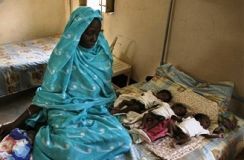Triplets overcome malnutrition in Darfur
June 18, 2006 (AL-FASHER) — Myriam Ibrahim thought she had seen it all: three years of violence during which her Darfur town was invaded twice; days in hiding as gunmen roamed the fields, preventing her from planting crops and making her family dependent on food relief.
 But she faced a new calamity last month when triplets doubled her children in number.
But she faced a new calamity last month when triplets doubled her children in number.
“I wasn’t expecting it; it was so difficult,” the tall, quiet 28-year-old said, wearing a bright blue robe as she recalled spending nearly 24 hours in labor in her hut, assisted only by a midwife.
Stress and hunger left her with no milk for the newborns. They were beginning to starve when a doctor with the U.N. Children’s Fund found them two weeks ago in their town, Mellit, and brought them 30 miles south to a feeding center in El Fasher, the capital of North Darfur.
When they were found, Fayrous weighed just over 5 pounds. Her sister Fardous was smaller. The smallest, Fawzia, weighed just 3 pounds, 5 ounces. Her head still looks huge in contrast to her tiny trunk and twig-like arms and legs covered by distended skin.
“At least one or two of them would have died of malnutrition within a few days if they hadn’t come here,” said Afaf Briena, a UNICEF nutritionist who is monitoring the babies’ progress at the government-run clinic.
More than 180,000 people have died in Darfur since 2003. Most were women and children killed by conflict-related malnutrition and disease, aid workers say.
While a huge relief effort reduced hunger and malnutrition last year from 22 percent of the region’s population to 12 percent, aid workers say they will face an immediate crisis if it goes back to 15 percent.
Infighting among Darfurian rebel groups has cut off international aid to entire areas. That, and a lack of funding, could severely threaten the food supply to more than 100,000 people during the “hunger gap” that afflicts the vast arid region of western Sudan during the crop-less July-September rainy season.
At El Fasher’s feeding center, with some 40 beds for mothers and their emaciated infants, the effects are already apparent. “Our number of cases has more than doubled since early May,” said Jamal Abdallah, the Sudanese doctor who runs the clinic. “There isn’t a single free space.”
In the ward with the most serious cases, a large painted Mickey Mouse smiles from the wall at babies who lie in a deep sleep next to their mothers or sit motionless, eyes staring emptily.
“Hunger has sucked most of the life out of them,” the doctor said, explaining the eerie silence in a clinic full of babies.
Intravenous tubes feed each infant antibiotics and other medicines because many have severe diseases, including malaria or tuberculosis, the doctor said. A tube through the nose delivers liquid proteins, because malnutrition has sapped the infants of the energy to eat and their organs can’t process normal baby food.
“In phase one, babies don’t gain weight. We just turn them back into human beings, so they can eat and cry again,” Abdallah said.
A mother walked by, distributing dried dates to nurses and the other mothers to save for a token gift to clinic personnel when their babies are ready to be discharged. “On average, only one baby dies each week,” the doctor said.
The triplets stayed in a separate room for infants under 6 months old, the age when they are particularly vulnerable to disease. All had gained sufficient weight over two weeks and were ready to be discharged.
“I have to go home soon. I have three other children to look after,” Ibrahim said.
She is from one of the ethnic African tribes that have suffered most at the hands of the Arab militia in Darfur. Her town is now relatively safe, but it is too dangerous for her to ride several hours a day by donkey to and from her plot of farmland, so she hasn’t planted crops this year.
She said her husband married a second wife and stopped supporting her.
Margaret Schenkal, a Swiss nurse at the feeding center, said she would get the mother a goat so she could give the milk to the triplets.
“It should do for the first six months,” the nurse said. “But what will they eat after that?”
(ST/AP)
